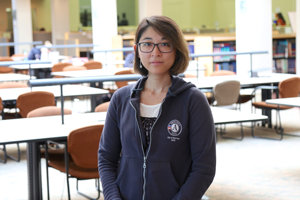 |
|
|
Liz Allen |
|
 |
|
|
Jennifer “J” Moon |
Biomedical sciences graduate students spend most of their years in training at a lab bench conducting experiments. While this is great preparation for a career in academic research, university research faculty positions are in limited supply.
Students at the Graduate School of Biomedical Sciences are getting out of the labs to expand their professional horizons in the new Career Pathways Communities, which were established last year. The program is the latest innovation of the GSBS Center for Biomedical Career Development, launched with a National Institutes of Health Broadening Experiences in Scientific Training (BEST) grant, and led by Cynthia Fuhrmann, PhD, a nationally recognized leader in career development curricula for doctoral students.
“We have integrated career planning into the curriculum from the beginning to the end. The Career Pathways Communities take place in the middle of training, when students who have passed their qualifying exams are ready to learn more about different career options and to explore interests they’re finding are personal to them,” said Dr. Fuhrmann, associate professor of biochemistry & molecular pharmacology and assistant dean of professional and career development for the GSBS. “The concept here is to make career exploration no longer an isolated effort, but instead something done with peers who share career interests with them.”
Career Pathways Communities comprises eight thematic pathways: research in academia and government; research in industry; business and commercial development; academic and research administration; policy, legal and regulatory affairs; public health, medical testing and patient care; science education and outreach; and science communication and publishing. Students are required to participate in at least two career pathway communities, which they rank in order of interest.
Each community brings together five to 15 students with two professionals. In each of three sessions, students complete activities that are designed to inform discussion at a deeper level. They perform job simulations of a task common to the career path, get feedback from the pros and discuss how the task relates to what they would do in the real world.
Liz Allen, a participant in the science communication and publishing pathway, said the experience led her and a fellow student to consider curating a website where PhD candidates can publish their creative writing and artwork.
“I feel like I hit the lottery in respect to the Career Development Program and Career Pathways Communities,” said Allen, who is conducting her doctoral research in the lab of Eric Baehrecke, PhD, professor of molecular, cell & cancer biology. “I’m now taking steps to make sure I have experiences that will help me get a job in one of the areas that I’m interested in. I would not have done any of this without the program.”
Jennifer “J” Moon, a PhD candidate in the lab of Jeanne Lawrence, PhD, professor of neurology, also participated in the science communication and publishing pathway and looks forward to her next one.
“Its focus on career development is one of the biggest reasons I came to the GSBS. It’s helpful for me to constantly think about what I’m doing right now and how I can make this work for my future career goals,” she said. “Having these required sessions keeps us in that mindset, constantly thinking about how we can make ourselves more marketable for potential jobs. I’m open to everything.”
Related stories on UMassMedNow:
Fuhrmann in Human Gene Therapy: Progress being made in biomedical career training
GSBS Class of 2016 reap benefits of NIH-funded novel career development program
Nature editorial recognizes novel GSBS career development program
Matthews and Fuhrmann working to reform biomedical research training, career paths
NIH grant integrates career planning with scientific training
UMMS tech tool helps scientists navigate career path